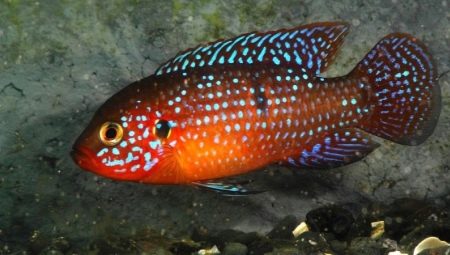Handsome chromis is a fish from the genus of chemichromis of the cichlid family. In European aquariums, it became widespread at the beginning of the 20th century as red cichlid or pearl cichlid.
Hemichromises are inhabitants of a wide range in Central, North and West Africa. Disparate populations are represented in the basins of the largest African rivers Niger, Nile, Congo. Ichthyologists distinguish several varieties of handsome chromis, differing in color intensity, body height and fin shape. However, these differences do not allow to distinguish subspecies.
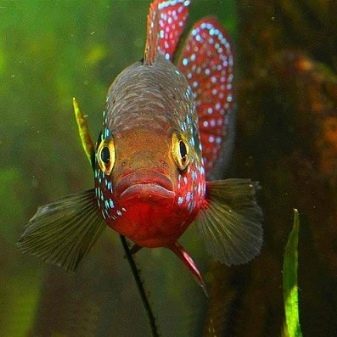

Description
Like many cichlids, the handsome chromis is a predator. The whole type of chemichromis is characterized by a relatively large head and body, which in comparison with many cichlids can be considered extended, the dorsal and anal fins are long, pointed in males.
For beauties, a red color is characteristic, its intensity may vary slightly. There are varieties with an orange tint. The back is usually darker. The sides may have a greenish tint. Bluish-white spots are scattered throughout the body, glowing spectacularly even in weak reflected light, they become the brightest during the spawning period. In the middle on the sides there are clearly defined paired dark spots. Some forms have paired spots on the gill covers and at the base of the tail. Despite the average size for aquarium fish - up to 12 cm - in natural reservoirs it grows to 27 cm, the fish is very aggressive, which greatly complicates its maintenance.
However, unusual for fish, characteristic of the majority of cichlid behavior, despite its inanimate character, makes them popular inhabitants of aquariums. The fish are territorial and can attack any fish that invades their territory, even if it is larger. The handsome men placed in the aquarium, having examined their new home, immediately begin to share it. To reduce stress, fish have to help with this by delimiting the bottom of the aquarium into sectors and zones using snags and stones. So it’s easier for them to mark the boundaries of their site.
Aggression and territoriality increase during spawning.
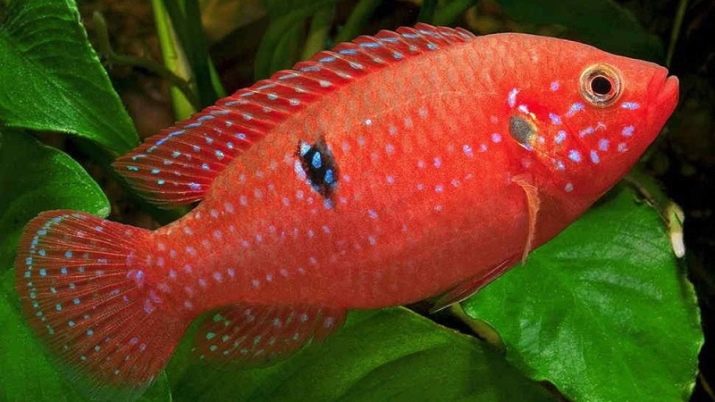
Kinds
Among aquarists, an opinion has been firmly established regarding several types of handsome chromises, which not all ichthyologists agree with, explaining this diversity by the influence of living conditions on representatives of one species. Indeed, all known varieties of these fish easily and successfully interbreed with other varieties, giving rise to even more options.
The most widespread in the aquarium are three forms of handsome chromies.
- A real handsome chromis. The name, of course, is conditional. This form was described first. It is distinguished by the absence of a dark spot near the tail.
- Two spotted is characterized by two distinct dark spots.
- Tall. It features a higher body and higher fins. The spots are less pronounced.
A relatively new form - neon chromis - is gaining more and more popularity. In this variety, light spots are somewhat larger and often combine into a peculiar individual pattern. There are no dark spots at all, in their place the bright spots become smaller, sometimes they are absent, and then these areas remain orange-red. Another new, rapidly spreading variety - the hybrid form, which has a very bright red color, is called the red handsome chromis.
Blue-green chromis distributed in the last quarter of the 20th century have nothing to do with chemichromis, and indeed with cichlids. They got their name only for their external resemblance. These are inhabitants of the tropical seas of the Indian and Western Pacific Oceans. These schooling flocks are great for a marine aquarium that mimics a coral reef, but are absolutely unsuitable for keeping in fresh water.
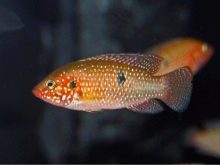
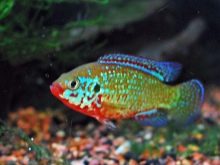
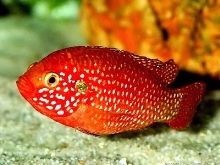
Who can I keep with?
The compatibility of handsome chromies is very low. If inexperience plant this fish in a reservoir, where various peaceful fish coexist for a long time, calm will come to an end. Even young chromies actively hunt, including smaller representatives of their species. It is absolutely impossible to keep fish smaller than them in one reservoir with them, unless as a living feed.
Some other cichlids, active large barbs and chain catfish can get along with them of the same size. Even large, but slow scalars or gold fish will soon be left without fins and die. Chromies will eat almost all small snails, and large ones will be killed by biting them with tentacles. Shrimps will be an excellent food for handsome people; crayfish during molting run the risk of being left without limbs. Even amphibians (frogs, axolotls, and some others) can be killed by chromis.
The territorial behavior makes the fish very lifeless, even to individuals of the opposite sex of their species, so a pond of less than 100 liters can be a comfortable home for only one handsome man. You can try to form a pair during the spawning period, but the young that have appeared, when it begins to feed on its own, will have to be separated from the parents, otherwise it can be destroyed.
Plants will not grow in the aquarium with chemichromis - although these fish and predators, they also need plant food, and they are happy to eat young shoots. But most importantly, chemichromis actively digs the soil.Even floating plants run the risk of being bitten and ragged from the hooligan motives and curiosities inherent in these fish. Only hard-leaved with powerful rhizomes Anubias is able to adequately resist the onset of chromis.
Weaken, but not exclude, the attack of the handsome can planting plants in pots.
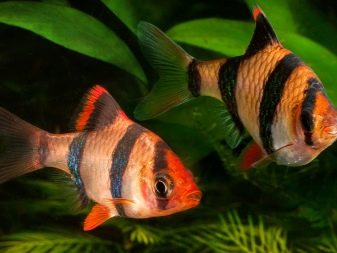
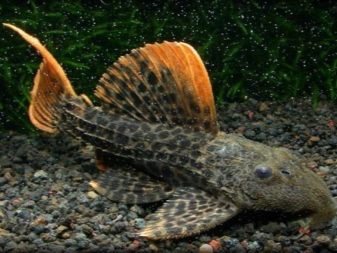
Growing conditions
It’s easy to take care of handsome chromies. They have no special requirements for the composition of water. At home, they feel great both in rivers and in standing reservoirs, including in swamps. For life, choose a site that has a natural shelter - driftwood, reed beds, rocky ledges, etc.
In the aquarium where these fish will live, you need to create several different shelters. The creation of shelters is a necessary condition for the maintenance of handsome men, if there are several. Otherwise, sacrifices are inevitable. If the fish cannot find a suitable house for herself, she will try to “build” it, digging up stones and driftwood, changing the landscape created by the aquarist. This work can completely destroy any rooted vegetation, and the slides made of stones laid by the aquarium-maker will be destroyed. It is important not to place structures made of large stones on the sand: if they fall, they can damage the side glass of the aquarium.
The most comfortable temperature for chromis is considered to be + 24–26 ° C. In the aquarium, where spawning of handsome men is supposed, the temperature will have to be increased to + 28-30 ° C. Lowering to + 20 ° C is undesirable, and below + 18 ° C is unacceptable. Chromis reservoir will have to be constantly heated.
Fish do not tolerate fresh water. This makes caring for them even easier. It is only necessary as necessary to add water evaporated from the aquarium. Since these are fish actively digging in the aquarium, you need a powerful filter, preferably an external one. Due to the lack of plants, constant aeration is required.
A cover glass is necessary not only because of the intense evaporation of a warm-water aquarium, but also because fish, carried away by hunting or chasing, are able to jump out.
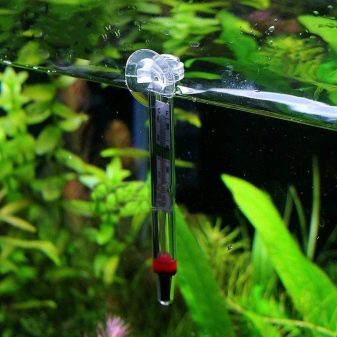

What and how to feed?
A healthy handsome man has an enviable appetite. There is no particular intelligibility in food. If food is not limited, chromis usually overeats, as it will try to eat all the food that was given to it. Digestion problems often cause the death of completely healthy fish. Usually, to calculate a single serving for one chromis, they take the amount of food that they eat in 20 seconds.
Most preferred are live food: bloodworms, earthworms, tubule, fish fry. Often, guppies specially bred in a large spawning aquarium are used as live food. It is advisable to alternate live food. As protein top dressing, you can give chopped low-fat beef, finely chopped fresh shrimp, boiled egg.
From time to time, for example, once a week, it is recommended to give plant foods: slices of cucumber or zucchini, chopped lettuce, ground oatmeal. Chromis and special food, produced for cichlids of various sizes and ages, eat well. However, dry food is still necessary and as often as possible to diversify alive. It is recommended to feed fish once a day, spawning or preparing for spawning producers can be fed twice a day. The diet of the growing fry can be 4 times.
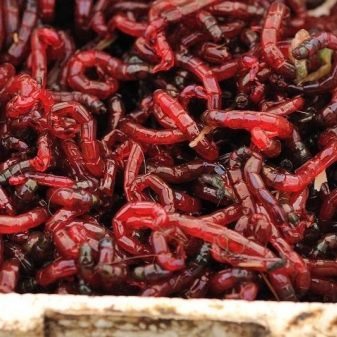
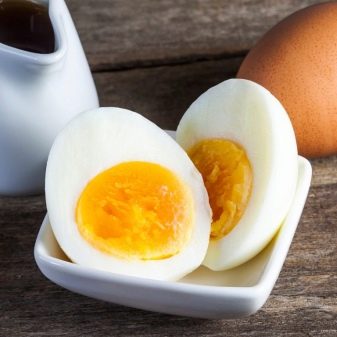
Sexual differences and reproduction
In all cichlids, sexual dimorphism is expressed rather weakly. With sufficient experience, it is possible to distinguish fish of different sexes more confidently. With the beautiful chromies, everything is exactly the same. It is believed that a male of the same age is somewhat larger than a female. However, this rule does not always work. A more reliable sign is the form of unpaired fins, dorsal and anal. In males, they are more pointed at the end. This symptom will work when fish of one species of handsome men are compared. If there are several different varieties of chromis in front of the aquarist, you can easily be confused.In this case, a brighter color will not be able to become a unique hallmark of males.
If you need to deal with the offspring of one pair, then all of these signs can be useful.
Obtaining fry of chromis-beauties is usually not a problem. The problem is creating a pair of manufacturers. Aggressiveness of fish in relation to individuals of its species often becomes the main obstacle to the successful breeding of cichlids. Creating a pair is complicated by the intolerance of fish to any neighborhood. Chromis males engage in fights with any fish invading their territory, even if it is a female. Often, in the process of pairing, several fish die, more often females, since they are still smaller and therefore somewhat weaker than males. The death of males is also not excluded.
To create a pair of chromies, ready to start spawning in a small aquarium (less than 100 liters), is generally impossible.
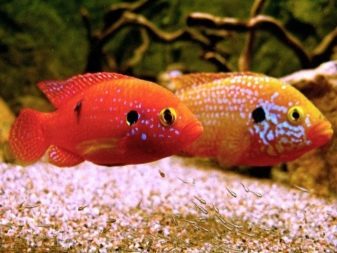
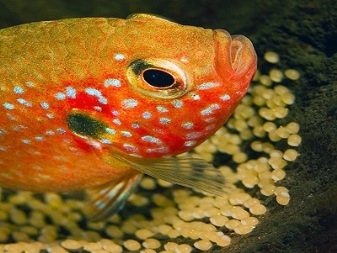
It is recommended to accustom future manufacturers to each other gradually. To do this, the spawning aquarium is separated by a glass partition. A male is placed in one half, and a female in the second. If signs of aggression are not observed, after a day the glass is removed. This is the most crucial moment, requiring the closest attention of the aquarist. If aggression nevertheless appears, the female must be sent off immediately, as she is likely to die. Again dividing the aquarium, you can try pairing with another female. If there is no aggression, then a pair can be created forever, chromis, like many cichlids, are monogamous.
Successful pairing can be observed by a change in the color of the male. It will become brighter, and light spots as if to increase in size. To stimulate spawning, it is necessary to increase the temperature in spawning to + 28 ° C (+ 27–29 ° C). At the bottom of the aquarium there should be large flat stones, which will serve as a substrate for laying eggs. The male actively cleans these stones of any debris, and in the sand builds shelters in the form of furrows and pits.
Both parents, as a rule, guard the clutch by attacking any approaching fish, even if it is larger. After hatching, on 2–4 days, the female hides them in one of the shelters built by the male. The next day, she drives the children into another hole. On their own, the fry begin to eat for about 3 days. On about 10 days, with a body length of about 1 cm, it is better for babies to be removed from adult fish in another aquarium. Parents stop caring for them and perceive them as prey. Among the young, cannibalism also begins.
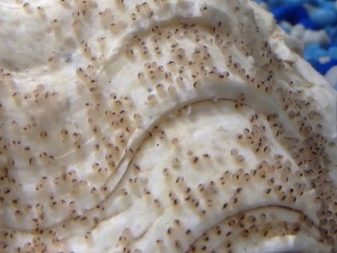
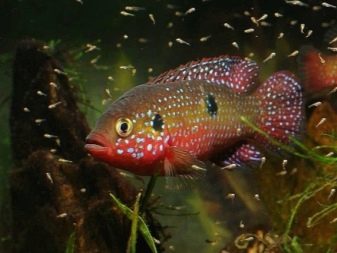
If the fish are not sorted by size groups, the entire offspring may die. There will be only one, the largest and most powerful fry.
For information on how to properly maintain and breed handsome chromises, see the next video.
